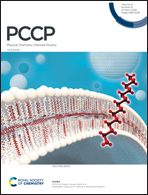Electronic structure, doping effect and topological signature in realistic intermetallics Li3−xNaxM (x = 3, 2, 1, 0; M = N, P, As, Sb, Bi)†
Abstract
Topological aspects of electronic structures have received intensive research interest in recent years. Here, we systematically investigate the electronic structure, doping effect and topological signature in a family of realistic compounds Li3−xNaxM (x = 3, 2, 1, 0; M = N, P, As, Sb, Bi). Without considering SOC, their electronic band structures show a doubly degenerate nodal line (NL) near the Fermi level in the Γ–A path. In addition, some compounds including Li2NaN, LiNa2N, Na3N and Na3Bi also exhibit one (or two) pair(s) of triply-degenerate nodal points (TDNPs) in the Γ–A path, locating at both sides of the Γ point. When SOC is taken into account, the band degeneracy of the NLs splits, and the scale of band splitting follows a positive correlation with the atomic weight of the M elements. Due to the band splitting by SOC, most of the Li3−xNaxM compounds show a pair of Dirac points (DPs) near the Fermi level. Very interestingly, we find that these DPs possess different types of band dispersions, namely type-I, type-II and the critical-type. The Fermi arcs from the DPs are identified. Our results indicate that Li3−xNaxM compounds are good candidates to study the novel properties of NLs, TDNPs, and DPs with different slopes of band dispersions.



 Please wait while we load your content...
Please wait while we load your content...